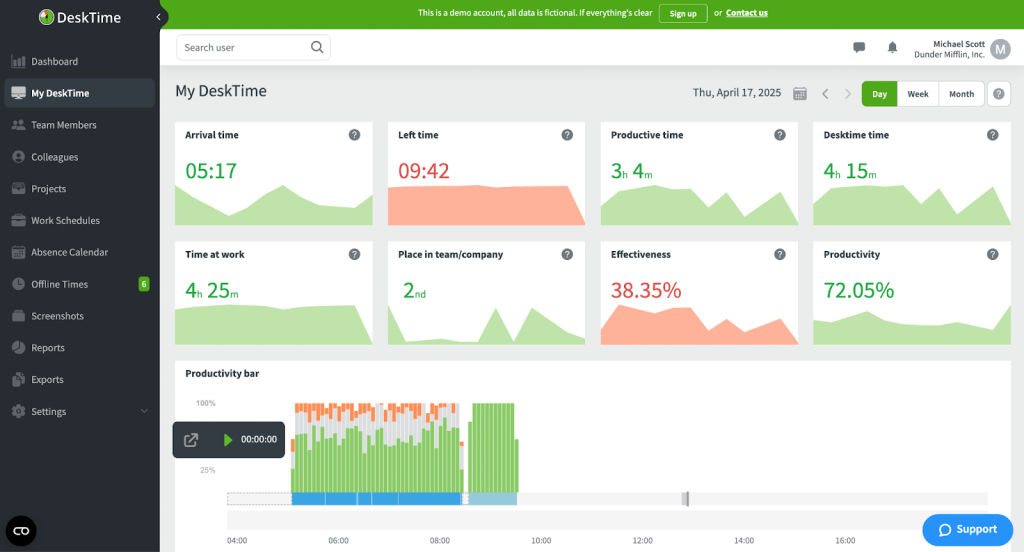Who works more—managers or employees? Study analyzes time spent in meetings, productivity, and more

Stereotypically, there’s long-standing resentment held by employees against managers—that managers do less work. Between the endless time spent in meetings and presentations of ever-shifting strategies, do managers even do anything?
Our team at DeskTime decided to weigh in on this classic conundrum by looking at our available productivity data. Spoiler alert: there might be something to the resentment.
Want to get the most out of your time?
Try DeskTime for free!
Try free for 14 days · No credit card required.
By signing up, you agree to our terms and privacy policy.

So, what did we do?
We took over 40,000 workers and split them into two categories—employees and managers—where the managers are those DeskTime users with manager and administrator privileges, and everyone else falls into the employee category. Then, we compared their productivity across all of 2024, with a special focus on time spent in meetings.
We looked at and compared:
- Average time spent in meetings: Time registered in Google Meet, Zoom, Skype (RIP), Microsoft Teams, Webex, and calendar event time.
- Average DeskTime hours: The time spent on the computer at work.
- Average productive hours: The time spent on productive (work-related) apps divided by the total time spent on the computer.
- Average effectiveness: The amount of time spent doing the right thing (productive time) for a predetermined amount of time (e.g., productive hours and set office hours).
Average time spent in meetings required some digging, but the other three—those are standard productivity metrics available on the DeskTime app. DeskTime makes it easy to get objective insights on productivity levels and trends in your company.

Study results: Productivity of managers vs employees (+ time spent in meetings statistics)
The results are in, and there may be a grain of truth to what employees have been saying all along. Here are fresh time spent in meetings statistics and more:
| Average | Managers | Employees | Difference (%)(Employees vs managers) |
|---|---|---|---|
| Time spent in meetings per month | 18h 34m | 10h 12m | 8h 22m (-45.88%) |
| Daily DeskTime hours | 4h 32m | 4h 56m | 24m (+8.89%) |
| Daily Productive hours | 4h 7m | 4h 25m | 18m (+7.32%) |
| Daily Effectiveness | 51.78% | 58.72% | 6.94% |
Takeaways:
- Managers have almost 2x more time spent in meetings than employees.
- Employees have nearly 10% more DeskTime hours than managers.
- Employees spend more of the working day doing productive things.
- Employees are essentially 7% more effective than managers.
So, the general conclusion is that the average employee works more than the average manager and spends 50% less time on meetings.
Some other interesting takeaways:
- In the monthly breakdown, we noticed that both managers and employees have an increase in meetings around October and November, likely related to companies holding planning sessions and performance reviews.
- Both employees and managers are less productive and work less in December, likely due to the holidays.
- Managers had more average tracked days than employees across the year, suggesting either that employees take more vacation days or managers are more prone to working on their days off.
Where does all of this leave us in respect to the original conundrum?

Breaking news: Study discovers managers spend more time in meetings!
Jokes aside, the difference in magnitude between the two meeting time numbers is quite significant, especially given how digital meeting time went up for everyone post-pandemic. Remote and hybrid work models have entrenched themselves as the new normal, demanding increased digital communication.
So, while managers spending more time in meetings isn’t particularly surprising, the fact that it’s twice as much—is.
Moreover, the numbers might be even higher. It is not uncommon for people to forget to register meeting time on DeskTime in various scenarios, e.g.:
- Large in-person meetings, where work is being done in parallel,
- In-person meetings that take place over lunchtime or other off-hours,
- Unofficial impromptu meetings at the desk,
- And others.
That said, these may apply to both employees and managers, and we’d expect the ratio of 1:2 to remain similar.
Meetings are work, too
Do managers actually work less? While the data certainly suggests so, given that meetings are more likely to go unregistered compared to easily trackable work, it would be unfair to draw that conclusion with absolute certainty.
Moreover, managers often have a lot of soft responsibilities that can be more difficult to quantify than, for example, time spent programming. Planning, strategizing, supporting, enabling, people management—their contributions are often invaluable to driving organizational success and productivity, while producing little tangible output that is directly trackable.
On a personal note, I cannot stand meetings. I’m extremely glad to have managers who can often take over the communication and organizational parts of work, allowing me to focus on what I enjoy and do best. If you feel differently—that managerial work is a walk in the park—perhaps you’re in the wrong position and should start proving that you’re manager material!

It’s not about managers or employees—it’s about productivity
At the end of the day, for a business, the time spent in meetings by managers or hours sat in front of a computer by employees doesn’t really matter. What matters is that work is completed effectively and efficiently.
That’s where tools like DeskTime come in handy. Automatic time tracking takes out the guesswork and uncertainty of measuring productivity, providing a clear and objective overview of how time is spent across the organization. By analyzing these metrics, companies can identify areas for improvement, optimize workflows, and ultimately boost overall productivity, regardless of job title.

Looking for ways to up your business?
Use DeskTime for time management, and always stay on top of your team’s efficiency ratings!
This study offers a data-backed perspective on a common workplace perception. While it highlights a significant difference in meeting time and some disparities in tracked productivity metrics, it also underscores the importance of understanding the diverse nature of work across different roles. Perhaps the conversation shouldn’t be about who works more, but about how different roles contribute to the overall success of the company and how to ensure everyone is empowered to be as productive and effective as possible in their respective domains.
Did you find this article useful? Give it a clap!
Psst! You can clap more than once if you really loved it 🙂